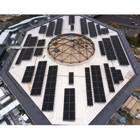SolarPV looks to a subsidy-free future

The solarPV industry is ready to move to a new stage with the effective scrapping of the feed-in tariff (FiT) and the closing of the Renewable Obligation scheme, believes Jonathan Bates, managing director of Photon Energy as he reflected on his company being 10 years in the business. His view on the two schemes is that ‘by and large, they have done their job’.
He explains, ‘Today, a 250 kW system installed for £900/kW of electrical output on a building where all the electricity is used on site can achieve an IRR (internal rate of return) of 7% with no FiT. The same calculation for a 50 kW system installed for £1000/kW gives an IRR of 5%.’
In comparison, for the last five years, the rationale for installing solarPV has been to maximise the revenue from a subsidy, so the decision to install a rooftop solar system has been a financial one and not an energy one.
Jonathan Bates says that this situation will change.’ With the value of ‘displaced’ electricity worth five to six times more than the generation tariff, the revenues from the FiT are increasingly irrelevant.
‘Rooftop solar systems are now being designed to maximise on-site energy use rather than fitting as many panels as possible on a roof to maximise income from a subsidy.
There are now over 870 000 solar-powered buildings with some 3.5 GW of rooftop solar installed in the UK. Photon Energy has installed of 21 MW of roof-mounted PV.
He summarises, ‘The solar industry needs to be planning for a post-subsidy world, and we need to be working now to ensure that we influence the landscape. Mechanisms such as Enhanced Capital Allowances for solar PV should be introduced, priority grid access maintained with guaranteed export revenues.
‘This would allow us to continue our journey towards subsidy free solar...and be free of the meddling and interference by politicians.’







